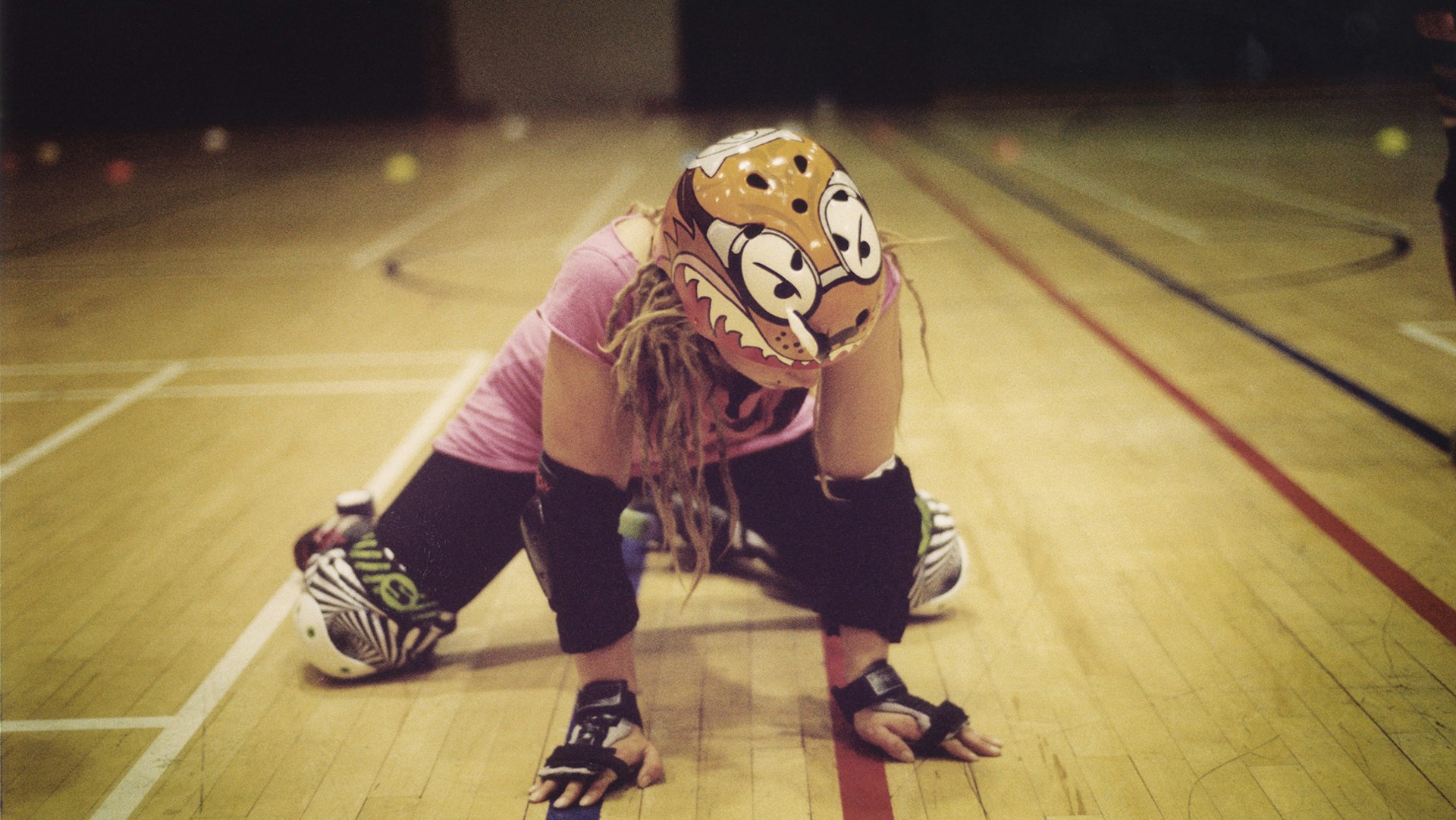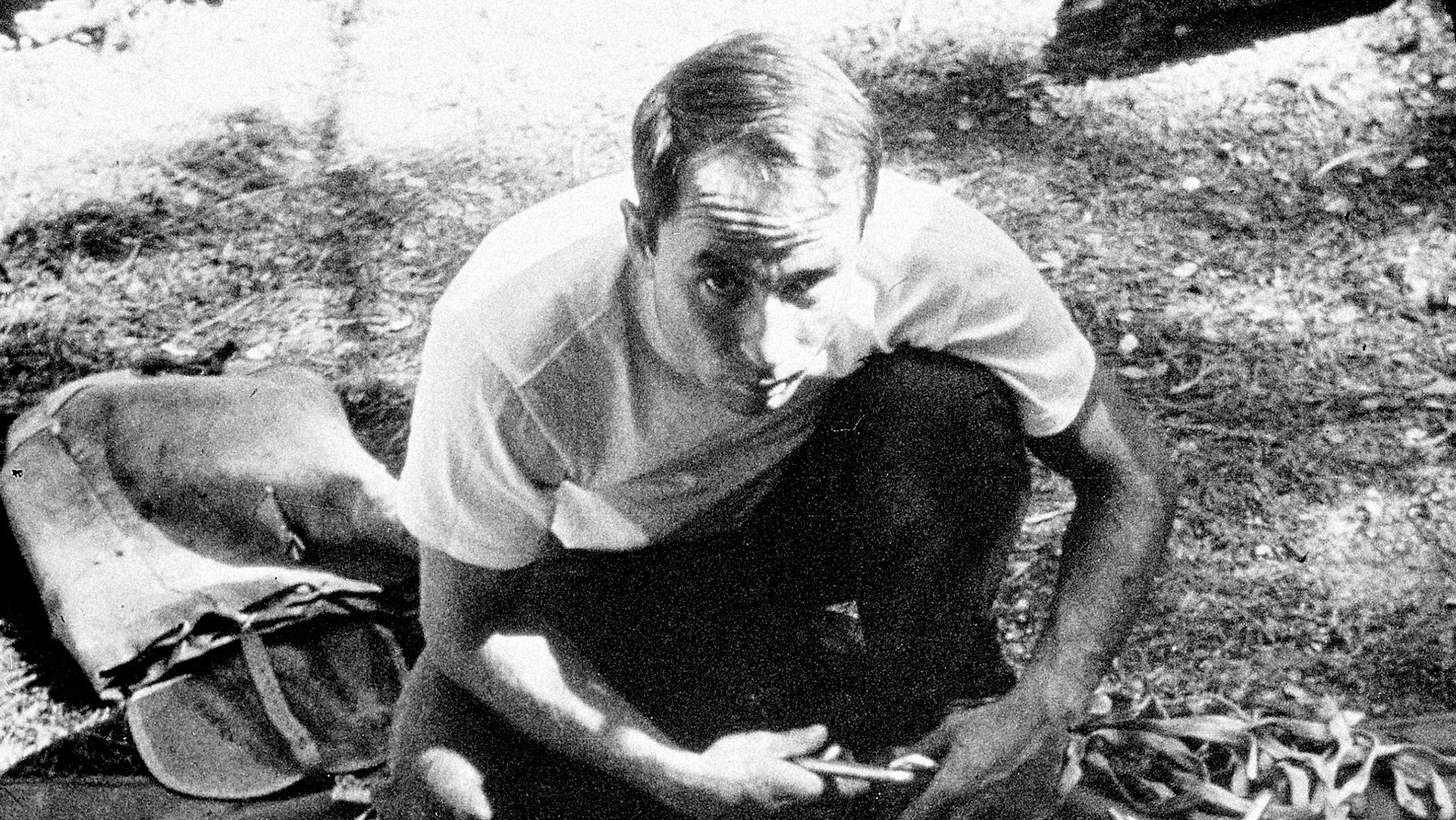
Roller Derby
- Text by Shannon Denny
- Photography by Niall O'Brien
Thundering around a slippery floor is a pack of women on roller skates. The London Brawl Saints are hurling their way towards defeating Glasgow’s IRN Bruisers. This alternative reality is a pink and black whirl of shoving, blocking, jamming and bouting. There’s a blur of kneepads, helmets and hotpants, as a tangled group suddenly goes down. Fast and furious skating continues in a flash, while a voice borrowed from the boxing ring booms out above the hooting, hollering and cheers to commentate on the exploits of heroines like Vagablonde and Grievous Bodily Charm. Violent and strange, it could be a Marvel comic brought to life, or a modern gladiatorial contest perhaps; squint your eyes and it could be rugby on wheels. But in fact this phenomenon is roller derby. And you’d better get to know it because you’re lying in its way.
Rolling Back The Years
Chicago promoter Leo Seltzer was the man behind this mayhem. He witnessed the success of Depression-era dance marathons that saw out-of-work hopefuls contending for cash prizes in days-long endurance contests, and in 1935 he launched a version on wheels. In his Transcontinental Roller Derby competing couples skated on a banked track for thousands of laps, equal to the distance from California to New York. When it proved a hit, Seltzer took his show on the road.
Impromptu collisions between contestants weren’t uncommon, and this led Seltzer to introduce nuances that radically altered the face of his invention: he incorporated body contact and started keeping score. The new sport pitted two teams of five skaters against one another, with sides scoring points when skaters lapped their opposition. It’s the same basic formula used today. From a relatively staid show derived from partner dances, roller derby became a spectacle of equal parts rock and roll.
In the 1950s television delivered derby to American audiences nationwide, and Seltzer’s rough and ready professional rollers became legends. His son Jerry took over and derby careened full tilt through the next decade, but screeched to a financial halt in 1973 when the Seltzer organisation was forced to shut down its show.
Other promoters attempted revivals, but it was a grassroots effort decades later that successfully seized the keys to the roller kingdom. The modern movement took hold in the college town of Austin where post-millennium pioneers the effected two important changes over earlier incarnations. First, new leagues took shape as entities run by the competitors themselves. Instead of a business owned and managed by promoters, roller derby would in fact belong to its own amateur participants. Second, by using skating rinks and gym floors, the innovators hatched flat track derby, relegating the infrastructure requirement of a banked track to the past.
The Texas Rollergirls Rock’n’Rollerderby league formed in 2003, and the Women’s Flat Track Derby Association took flight the following year. Today, thanks to a cocktail of irony and adrenalin, modern roller derby is as infectious as a virus and addictive as a drug. It’s gone from a handful of teams to 450 recognised leagues worldwide in less than a decade – nothing short of a pandemic.
Ladies Who Crunch
Thanks to the skater-owned and operated ethos, roller derby embodies DIY. According to the London Rollergirls I talk to, it’s about passion and commitment more than playing the right note or singing in key. “I’m actually pretty lucky,” laughs Erin No Bragh, “because I couldn’t really skate when I first started. And then right after my group started they got a little more strict – you had to have a certain minimum skill level!”
Even with entry requirements though, derby offers a uniquely level playing field that’s appealing. “I was Miss Extracurricular,” says Poddington Peeved who skates for the Ultraviolent Femmes. “But I was always the worst person in the band or the worst person on the hockey team. I wanted to do something where you had to learn. Because everyone has to do hockey and netball you kind of know how to play those, whereas no one really knows how to play roller derby – you can’t already have any idea of how to hit people while on roller skates.”
Dot Slash joined the Suffra Jets after spending her youth figure skating. “With figure skating you have to be a certain type of person who fits a certain criteria, and there’s no room for someone that’s a little bit different. I outgrew it; I didn’t like all the snobby mums and hairspray and glitter eye shadow.” Three years ago, roller derby supplied her with a gritty alternative and instant addiction. “When you get older you start to know who you are and what you like and don’t like. Stuff you do as a kid, often you do it because your parents want to keep you out of trouble – or in our village, stop you getting pregnant!”
Auntie Terror grew up in the States before moving to Britain and joining the Steam Rollers. “I did run track for a while, played a bit of field hockey. But once everything got competitive I wasn’t interested anymore. People were competing for sports scholarships, and I didn’t want a sports scholarship.”
Rejecting the conventional path is a common theme in roller derby community she says. “Quite a lot of us really are a bit dorky. I’ve talked to a lot of girls and found out that growing up at school they weren’t part of the popular cliques. There are a lot of nerds here. I think it attracts people that never quite fit in elsewhere, because it is so odd but also because it welcomes everybody. You don’t have to be a certain size or a certain shape or a certain background or a certain level; if you can skate and you don’t mind throwing yourself into people then you can find a league that will suit you.”
Even within a league or a team, the diversity makes stereotypes impossible. Some girls have tattoos, some girls are doctors – and some girls have tattoos and are doctors. “What I love is that although it’s alternative, you don’t have to be any type of person at all,” says Poddington Peeved. “As a sport it’s just incredibly open-minded. No one cares, no one bats an eyelid at anything you turn up wearing or doing.”
The superhero names and offbeat dress codes let rollergirls slip into new identities, and the invention of powerful alter egos echoes the plot of Revenge of the Nerds. “To me it’s a sport unlike any other because of the quirky character,” says Erin. Willowy and blonde, she’s a model by day, but when asked if she played sport in her youth the answer is revealing. “Oh my gosh – that’s the funny part. Everyone who knows me from growing up cannot believe I’m doing this because I was like a music nerd my whole life! I went from this not athletic person to where this consumes my life. It’s totally a passion.” And to prove the point she fastens her helmet, pops in a mouth guard and glides off to collect a couple bruises and kick some butt.
This Ain’t No Disco
So why is this movement happening now, and why’s it only women? A punk attitude pervades roller derby – from customised ‘boutfits’ to in-yer-face names that would do Sid Vicious proud. To understand punk you have to look at what preceded it; without anodyne disco to react against we wouldn’t have had the anarchic fury of the Sex Pistols or Dead Kennedys. To understand the phenomenon of rollergirls you have to look at what was happening in sport between derby’s premature death in 1973 and its miraculous resurrection in 2003.
These were the years that saw sport evolve from a leisure activity into a corporate commodity. Nike unleashed the Swoosh in 1971 and sponsored its first pro in 1978. ESPN, the American cable network dedicated to 24-hour sports coverage, debuted in 1979 and set a precedent for slick production that blurred lines between news and entertainment. Commercialisation was on the march in Britain too, where in 1978 Liverpool became the first club to ink a shirt sponsorship deal. Meanwhile the 1977 release of the film Pumping Iron is credited with spawning gym culture – and also launching the career of a little fellow named Arnold Schwarzenegger.
Sport was becoming more serious – and arguably more contrived. But for female sport in particular there’s one more piece to our puzzle, and that’s something called Title IX. Passed in 1972, this landmark legislation banned sex discrimination in all US schools and colleges receiving federal funding. The outcome was that for every boys’ team a school fielded, it had to also offer an equivalent for girls.
Title IX precipitated a boom in women’s organised sport in the US, and its lifespan coincides exactly with the trajectory of sport as a corporate enterprise. In these years administrators and advertisers were setting agendas, and those from the model mould – think Jane Fonda and Anna Kournikova – served as poster girls.
So maybe it’s no coincidence that the first generation of women in the Title IX era sought an alternative to mainstream sports and packaged icons available to them. In the same way that punk bands formed first and learned to play instruments later, girls get themselves on the track – a close cousin of the mosh pit – and dance like no one’s watching. The on-track violence makes the threat of injury perennial, putting a nihilistic two fingers up at the nanny state where it’s normal for parents to launch lawsuits when their kid falls over in the playground. And the pervasive irony found in witty wordsmithing and a cheeky aesthetic reminds everyone that sport should be fun, if not outright funny. Lacing up a pair of quad skates is like bidding farewell to the last days of disco; roller derby is punk rock on wheels.
